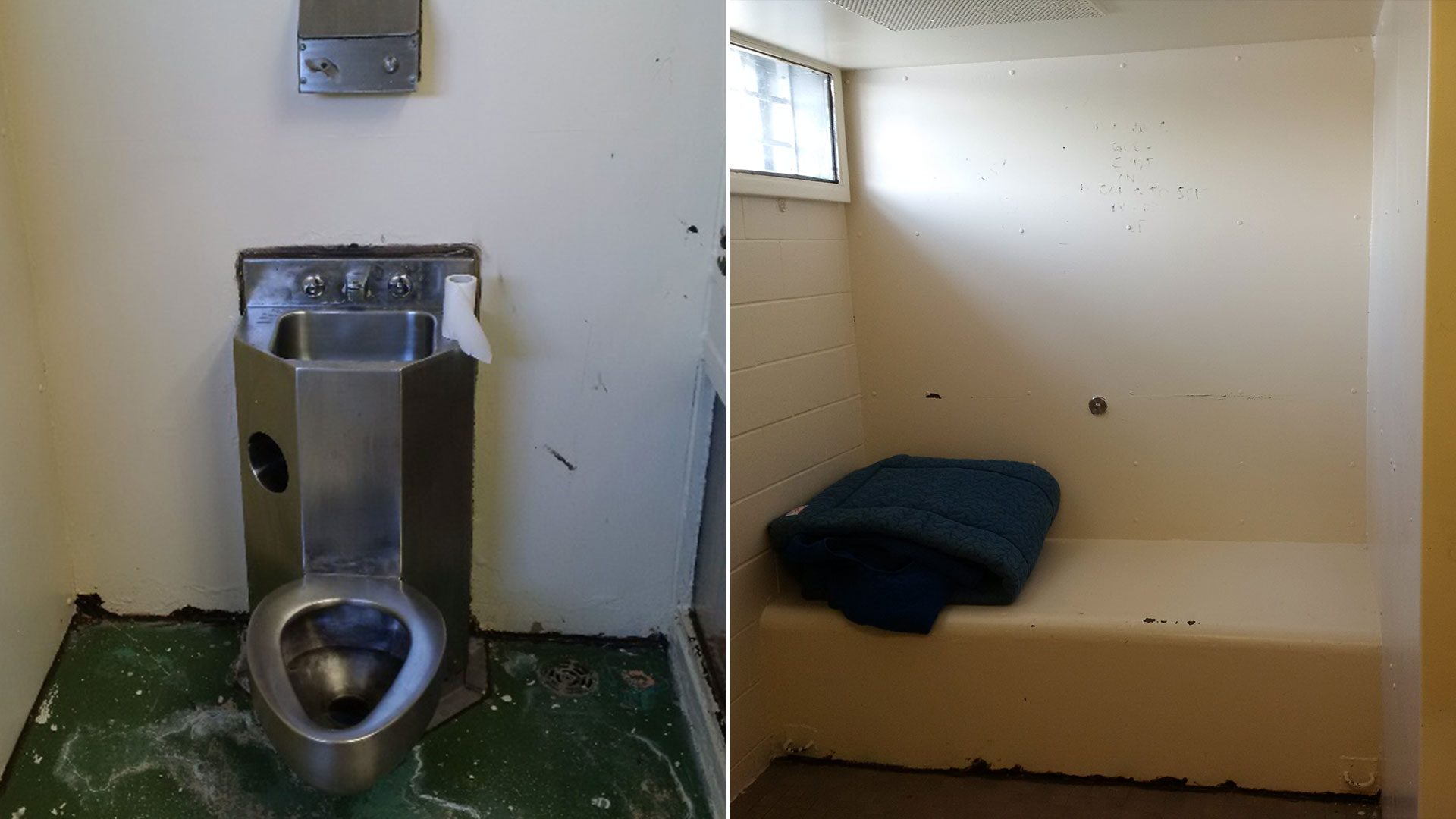
Lance Regan, 34, is suing the Correctional Service of Canada over his treatment in prison. Photo courtesy: Regan family.
Lance Regan, a 34 year-old Métis man who was suing the Correctional Service of Canada saying he suffered harassment, racial discrimination, false charges, abusive use of force, and torture at the Special Handling Unit (SHU) from 2012 to 2013 has dropped his case.
According to his lawyers, Regan struggled during his testimony.
“Unfortunately, after giving much of his evidence-in-chief, Mr. Regan again became highly anxious and indicated a desire to ‘shut down’ the process,” said Michael Schwartz from the law firm Kalman Samuels.
They say that Regan became so “traumatized” by his experience in custody, that he was unable to continue the case.
“This development is deeply disappointing and even surprising, but does not diminish our alarm and anger at the way CSC has treated Mr. Regan and others – both by direct acts of abuse as well as by consistently hiding, destroying or otherwise obstructing evidence that would allow inmates/victims to obtain justice.”
According to Regan’s statement of claim, “While incarcerated at the SHU, Plaintiff has suffered physical and mental abuses from prison officers.”
“Aside from the systemic abuses that the Plaintiff has had to endure, there have been four (4) major incidents of harassment and discrimination that all occurred in the same one-year period.”
Regan says his time at the unit has negatively affected him.
“It’s played a lot on my mental health because of the things I’ve been through, the things that I’ve suffered while incarcerated,” says Regan of his time spent at the SHU, which is located about 50 km northwest of Montreal as part of the Regional Reception Centre prison complex.
Regan is asking for $1.2 million in damages according to the statement of claim.
His lawyer Daniel Romano says the amount not only reflects the suffering endured by his client but also hopes that it will discourage further alleged abuse in the SHU.
“We have standards in this country of how people are to be treated, even prisoners, and sometimes even those standards aren’t good enough, but they should at least be met and respected,” says Romano.
The most serious event described in the lawsuit involved a use of force that Regan says left him injured and confined for 23 hours a day over five days in a cell that had been contaminated with pepper spray. Romano says this alleged incident meets the definition of torture.
“They left him in there, choking, coughing for five days,” says Romano from his Montreal office.
“Forget being a lawyer, as a Canadian citizen, I cannot accept our government and our federal agents doing that to people.”

Correctional Services Canada (CSC) declined to be interviewed for this story.
None of the allegations in the lawsuit were proven in court.
In an email, a spokesperson wrote that they disagree with the allegations made by Regan and affirm that CSC, “will further articulate its position before the courts as this case unfolds”.
Court documents submitted by the Attorney general of Canada in response to the lawsuit describe Regan as a “high ranking” member of the Terror Squad gang who “has spent his adult life committing heinous and gratuitous acts of violence…”
As outlined in the statement of defence, Regan does have a history of violence, with a lengthy rap sheet of weapons, drug, and assault charges dating from the age of 14 to 21.
But it wasn’t until he was incarcerated that he became a murderer.
“They forced him into a situation where he had to fight for his life and then he gets penalized for it,” says Romano “When he was in the Edmonton Institution before I knew him, he got double-doored.”
Double dooring is prison slang for the practice of confining two or more people in a space by locking the available exits.
“Edmonton Max was really bad, the guards there were setting up fights,” says Regan. “They put me out with an incompatible gang member. That guy attacked me, it’s clear that they set that up.”
According to Romano, corrections protocol dictates that incompatible inmates be kept apart.
“Whenever you go to prison, they [corrections employees] prepare a file for you and they note your background and they have a very strict guideline as to who are compatible inmates, they want to keep rival gang members apart, for an example,” explained Romano “And yeah, Lance Regan was attacked, he fought, he defended himself and regrettably the other fellow died.”
Regan’s description of what happened in Edmonton is brutally concise.
“Every time they f***ing popped that door I came out on top. Then it blew up in their f***ing face when somebody actually died.”
Mason Tex Montgrand, 21, was the man Regan stabbed to death in August of 2011.
Regan was 24 at the time.
As reported by CBC, Regan says in a parole hearing that Montgrand, a rival gang member, had a weapon made out of a razor and threw hot water in Regan’s face.
Regan was charged with first-degree murder, but his case made national headlines after his lawyers moved to dismiss the case because it violated his rights by taking too long to go to court.
The case was on its way to the Supreme Court in 2019 before the Crown abruptly dropped the case during appeals.
Regan and four other inmates also sued the warden and staff of the Edmonton Institution for the double dooring incidents.
None of their accusations were proven in a court of law, but in 2019 a settlement was reached out of court. The amount of money awarded in damages is unknown due to a non-disclosure agreement.

Regan isn’t the only one to accuse the Edmonton Institution of having issues.
The Edmonton Institution prison was the subject of an investigation by the Office of the Correctional Investigator (a corrections watchdog and ombudsman) who found that in 2018 “correctional staff and management tolerated an established history of bullying, harassment and assaults” of inmate-on-inmate violence.
The Correctional Investigator also says that “evidence shows these attacks were planned and orchestrated events that escalated over time and that EI [Edmonton Institution] staff and management consistently looked the other way when incidents occurred.”
In its most recent report, the Correctional Investigator says that a five-year study showed that Indigenous people, who make up 28 per cent of the prison population, were subject to 37 per cent of the nearly 10,000 uses of force incidents in prison from 2015 to 2020.
Leticia Gutierrez, a special policy advisor for the watchdog’s office, says that’s more than any other ethnic group.
“Based on the rather compelling evidence from our investigation, we conclude that force is indeed disproportionately used against Black and Indigenous persons in federal corrections in Canada, and that race is significantly and uniquely associated with the application of force in federal prison,” Gutierrez says during a February news conference.
Read More:
Black, Indigenous inmates more likely to experience ‘use of force’ behind bars: Prison ombudsman
Justice Canada study finds own criminal courts stacked against Indigenous accused
Romano says in Regan’s case, the corrections system failed in its mandate to rehabilitate.
“How is this beneficial to our society to be doing this to people?” he asks.
Romano says that before the pepper-spraying incident in the SHU, the electricity had been shut off in Regan’s cell for four days as a punishment, one day longer than regulation.
According to the statement of claim, when complaints fell on deaf ears, Regan protested by blocking his food tray with his arm, after which guards hit Regan’s arm with a baton and used pepper spray.
In court documents, a lawyer for corrections argues that Regan was in fact trying to grab guards through the food slot in his cell and has labeled it an “attempted assault”.
Romano argues that if guards had followed protocol, this wouldn’t be a tale of he said/she said. Instead, there appears to be mass of missing evidence.
“So not only are there video cameras in the institution that are fixed, the fixed angle ones that show onto the hallway but they’re supposed to bring in another handheld one for a close up for what they’re doing.”
In court documents, counsel for the attorney general state “certain formalities were lacking” but that the “intervention was reasonable in the circumstances”.
They also say the cell was cleaned following the incident and that Regan was given two showers following a visit to the nurse.
As for the extra day of no electricity, that’s chalked up to an “administrative failure” and court documents state that the original paperwork regarding the reason for the punishment “could not be found”.
“This could happen once,” says Romano “but it’s the supermax, it’s a high-security institution, they have a means of doing things and keeping track of these things, so even once I find it suspicious, but over and over and over again? They’ve lost it, they’ve erased it, technical difficulties, they can’t locate it, c’mon!”
Another incident described in Regan’s lawsuit involved the SHU refusing to allow him access to a pipe ceremony on three separate occasions over the course of seven months following the death of a brother, an uncle, and a family friend.
According to court documents, the reason given for the refusal was that Regan was a “high-level security threat.”
“They really lack on having elders and ceremonies and things like that,” says Regan, who grew up in Prince Albert, Sask., but has roots in the Green Lake Métis settlement.
“All these Indigenous people are just lost and forced to grieve on their own [in prison]. They denied me a lot of ceremonies, proper ceremonies that I should have done to grieve properly. So now I’m stuck dealing with that pain and anger.”
Indigenous adults make up nearly 30 per cent of incarcerated people in Canada despite making up less than five per cent of Canada’s population.
On its website, Correctional Service Canada says it recognizes that Indigenous people “have been directly impacted” by events such as colonization, the ‘60s Scoop, and residential schools, and has committed to offering programs to Indigenous inmates, such as elders and weekly ceremonies.
But Regan says when the services aren’t being denied, they are woefully inadequate.
“What they need to do is implement more Indigenous circles, ceremonies, bring more elders to speak to the people, have more programs that are more Indigenous based so that they can use these tools they learnt on the inside and apply them when they get out so they’re not lost,” says Regan over the phone from Saskatchewan federal penitentiary in Prince Albert, where he is currently serving a two-and-a-half-year sentence for drug and traffic offences.
When asked if he felt Canada’s correctional system had rehabilitated him at all Regan says, “Not at all. Tormented my mental state of mind. Physical too, for all the time I spent all twisted up in Quebec SHU and Edmonton max.”
Do a google image search of Lance Regan and an image like this usually pops up:

The “perp walk” is familiar to anyone with a passing interest in crime, real or fictional.
It’s a fleeting moment of drama, where the police escort an accused person (or “perpetrator”) from a vehicle to court, frequently through a gauntlet of photographers and video cameras should the crime be scandalous enough to merit media coverage.
Usually, the accused does their best to hide their identity by covering their face and hurrying forward.
That’s what makes this 2011 photo of Lance Regan stick out. This is not a man who hides from cameras, or anything really.
This was taken on the day Regan was sentenced to 10 years minus time served for aggravated assault, robbery and unlawful confinement.
The look in his eyes could be interpreted in many ways. Defiance. Rage. Contempt.
Corrections Canada took control of this then 23-year-old Métis man’s rehabilitation on this day.
Some say, by many accounts, they failed.
When asked what he would say to this young man today, Regan says.
“This life [of crime] is not worth it. Try to find something that you love to do and try to pursue that,” he says.
Regan also adds that he wishes he had put his family first.
His case against the CSC was being heard in Quebec Superior Court in Montreal. The hearings are expected to continue until mid-May.
Regan is eligible for full parole in September and hopes to pursue a career in mining when released.
Editor’s Note: This story was updated May 16, 2022.










